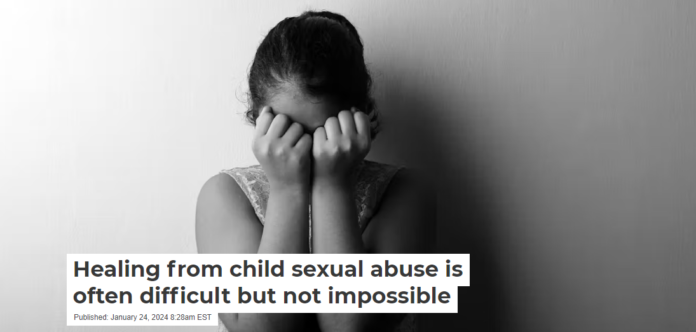
Maria Khan, PhD, West Virginia University
A mayor, a karate instructor, a former cop, an award-winning journalist and a pastor. All five of these individuals in positions of authority or trust made headlines within the past year in connection with childhood sexual abuse.
Beyond the headlines and whatever punishments are meted out, each heinous case is alleged to involve a child who endured unjustifiable suffering and is left with the burden of carrying the weight of this trauma.
As a child clinical psychologist who regularly provides therapy for survivors of childhood sexual abuse, I can attest that traveling the uphill path to healing from such experiences is arduous – but it is possible.
How many children endure sexual abuse?
Child sexual abuse is sadly a common occurrence. About 1 in 4 girls and 1 in 20 boys in the United States are subjected to child sexual abuse – maltreatment of a child involving molestation, rape, prostitution, pornography and any sexual contact without consent.
According to the most recent federal data, approximately 60,000 children were confirmed victims of sexual abuse in 2021.
However, true rates of child sexual abuse are unknown, as only 10% of cases are reported to law enforcement. An estimated 60% to 70% of adults who were sexually abused as children kept it a secret throughout their childhood.
Who are the perpetrators?
The majority of child sexual abuse perpetrators – 93% – are someone the child knows. Thirty-four percent of perpetrators are family members, and only 7% are strangers.
Father figures and male family members are the abusers in more than a quarter of child sexual abuse cases.
Evidence points to younger children being more likely to be abused sexually by a family member than by an acquantance. Around 49% of sexual abuse cases against children under 5 were committed by a relative, versus about 24% for children aged 12 to 17.
In such cases, children are particularly vulnerable to coercion and secrecy. This can lead to greater likelihood of the child sexual abuse going unreported due to fear, guilt or shame, and concern about getting into trouble.
How have the internet and social media changed things?
As more children have access to various online platforms, they may become even more susceptible to unwanted sexual conversation, grooming and online sexual abuse. Teenagers, rather than younger children, are at greatest risk for encountering a sexual perpetrator online.
A recent study found that 1 in 15 teens are exposed to unwanted sexual material online, while 1 in 9 are exposed to sexual conversation by adults or peers. Approximately 8.5% of adults who were sexually abused during childhood reported meeting a perpetrator online, via social media or other online apps.
Since the dangers that youth face online mirror dangers in real world settings, teaching internet safety skills in the context of sexual abuse and bullying education is encouraged by researchers.
What’s different for extremely young victims?
Research suggests that about 30% of child sexual abuse cases involve children age 4-7.
Preschool-age children who were sexually abused reported more depressive symptoms than preschool-age children who were not abused. Moreover, younger age of abuse predicts worse future mental health problems, including anxiety, depression and behavioral difficulties.
Due to their limited understanding and knowledge, young children are at a significant risk for being “groomed,” especially by those in positions of trust, and may be less likely to disclose abuse.
Developmental problems are also a cause for concern if abuse occurs during the 0 to 5 age range – the most pivotal time for brain development. Compared to adolescents, younger children are more likely to display physical trauma-related symptoms, such as sexualized behaviors, wetting accidents and other developmental delays, following abuse.
Despite their age, younger children benefit from learning about sexual behaviors, boundaries and private parts. They make the most progress in trauma therapy with caregiver participation.

What does it take for children to recover?
The most important aspects for recovery after trauma are abuse disclosure, consistent support from safe adult caregivers, and therapy. Children who are exposed to any inappropriate sexual activity or abuse are strongly encouraged to report the abuse to a trusting adult. The sooner children report being a victim of sexual abuse, the fewer future psychological difficulties they experience. Additionally, caregiver support strongly predicts resilience in children who were sexually abused.
Regrettably, the most common reasons cited for not disclosing child sexual abuse were: shame, believing the incident was not serious enough, lack of proof, self-blame, fear of negative reactions from others, and fear of not being taken seriously. So, if a child decides or agrees to report the abuse to law enforcement authorities, caregivers and professionals are urged to be supportive to lessen the negative impact of disclosure.
Children who have endured sexual abuse may benefit greatly from trauma-focused therapy. Goals of trauma-focused therapy often include learning skills to help deal with difficult thoughts, feelings and behaviors following the abuse. The therapy also involves talking through their trauma in a safe and healthy way, and learning safety skills such as healthy boundaries and assertive responses to threatening situations.
Are normal lives possible?
Child sexual abuse can have far-reaching and lifelong consequences. Children who endure sexual abuse demonstrate more difficulty understanding and managing their emotions, and experience more anxiety, depression and behavioral problems.
Adults who were sexually abused as children are at greater risk for worse physical health, such as gastrointesinal, sexual health, neurological and respiratory problems, as well as chronic pain. They are also at greater risk for worse psychological health, including post-traumatic stress disorder, anxiety and depression, among other disorders. Further, they are at greater risk for substance abuse, marital problems and suicide.
These things notwithstanding, many children are quite resilient. They can and do recover from such experiences, especially with abuse disclosure, caregiver support and treatment.
Therapy and support from caregivers contribute greatly to healing and protection against future physical and psychological consequences. One of the core tenets of trauma-focused therapy is for an individual to regain control over their life, experiences and trauma.
With the support of loved ones and specialized, professional help, children and adults who have endured child sexual abuse can be resilient and successful in all domains of life.
Maria Khan, PhD, Assistant Professor of Behavioral Medicine & Psychiatry, West Virginia University
This article is republished from The Conversation under a Creative Commons license. Read the original article.




















